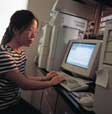 Eat
your procyanidins With a grant from the American Cancer Society, Mitchell is studying whether mice fed a diet high in purified procyanidins experience a greater induction of glutathione S-transferases than mice fed a standard diet. Then, she'll use state-of-the-art liquid chromatography and mass spectrometry to measure the expression of glutathione S-transferases isoenzymes in the cells. She'll also look at the ability of procyanidins to protect against laboratory-induced free radicals. She'll use this information to identify the mechanisms by which procyanidins protect against cancer. "We're looking not just at molecules in a jar, but which foods have higher levels of procyanidins, so that we can make useful distinctions," she said. Her project is one of many at UC Davis seeking to identify how constituents in the diet may prevent cancer. Key players include scientists from Lawrence Livermore National Laboratory, the United States Food and Drug Administration's Western Human Nutrition Research Center, the UC Davis Departments of Nutrition, Agriculture, Epidemiology and Preventive Medicine, Mitchell's home Department of Food Science and Technology and individual investigators scattered throughout the Division of Biological Sciences. Their efforts and more are part of the UC Davis Cancer Center program in cancer control. After all her work is done, Mitchell expects no greater revelation than the advice given by dietitians (and mothers) everywhere: Eat your fruits and veggies.
Home |
Table of Contents |
To our Readers |
Building on Basics UC Davis Health System | © 2000, 2001, 2002 UC Regents. All rights reserved. |
Yun-Jeong Hong, a food science and technology graduate student, analyzes the procyanidin content of various foods. |

